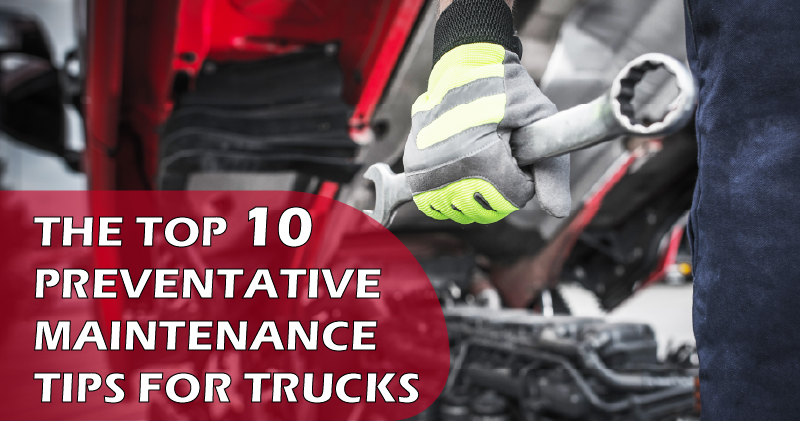
Do you ever wonder what maintenance costs your company money? Are you aware that poor maintenance can cost you money? We often hear about a company that has invested thousands of dollars in new trucks only to see them fall apart within the first few months of use. Or maybe you’re just an average Joe or Jane who doesn’t know any different. Either way, keeping a watchful eye on your equipment can save you money in the long run. Here are the top 10 preventive maintenance tips that will help keep your equipment performing at its best:
-
Check your tires regularly
Your tires not only protect your truck from damage, but they also help keep it from getting stuck. Make sure they are properly inflated and not cracked or bald. And, while you’re at it, change them at least every 400-500 miles. When your tires go flat, it can be hard to see the effects of poor maintenance because the tread is worn off. If you have a busy route where you’re on your feet a lot, it’s easy to neglect this check. And, when it comes time to replace your tires, make sure you check them for certification before buying new ones. The recommended tire changing schedule is shown below: Regularly checking your tires and changing them as necessary will help keep your truck on the road and prevent costly downtime caused by flats, road rash, and other costly issues.
-
Check your brakes
You want to be sure you can stop safely while carrying a large load. Check your brakes frequently, and replace them when they are at the minimal wear level. Observe for even wear from front to back and from side to side. This may indicate that your brake system needs to be adjusted or repaired to offer proper braking performance.
-
Check your gearbox and clutch
Even if your truck is in good shape, it will only stay that way for a while. Eventually, your gearbox and clutch are going to need maintenance. But don’t skimp on these necessary maintenance items. Every time you get on the road, the combination of high-torque engines and large loads puts much strain on your gearbox and clutch. You can prevent problems from developing by regularly inspecting your gearbox and making sure it is operating correctly. Additionally, you should check to see if your clutch is slipping since this can reduce reliability and fuel efficiency.
-
Change your oil and filter
It doesn’t matter if you drive an automatic or manual truck; changing your oil and filter regularly keeps your engine bearings and other vital parts from getting out-of-date. Check your owner’s manual if you’re unaware of how often these items should be changed. The number of miles you drive, the weight of the cargo you carry, and the driving you perform will all affect how often you should change your fluids (highway, dusty roads, city traffic, etc.) Always change fluids according to the manufacturer’s recommendations. In the short term, trying to extend the life of your fluids may save you money, but in the long run, it will cost you a lot in repairs and breakdowns.
-
Check your spark plugs
Your spark plugs should be checked at least once a year, preferably more often if you drive in cold weather and your engine runs hot. Spark Plugs should be changed simultaneously with your oil and filter. The recommended sparkplug maintenance schedule is shown below: Make sure you check your spark plugs regularly. If they look bad, it could result in expensive engine damage. And it would be best if you changed your spark plugs whenever possible.
-
 Check your fuel system
Check your fuel system
Your fuel system should be checked at least once a year. This is because it could be contaminated, resulting in engine damage, loss of power, and increased repair costs. The recommended fuel system maintenance schedule is shown below: Make sure you check your fuel system frequently. A clean fuel system can lead to good performance and costly repairs. And it could also lead to carbon monoxide poisoning. Make sure you have clean fuel lines and a clean fuel tank. You should also perform a fuel system check whenever you get the chance. The routine for checking your fuel system is shown above.
-
Change your air filter regularly
Your engine needs fresh air to run at peak performance, so it’s a good idea to change your air filter regularly. This helps remove factory-issued HAZMAT restrictions and cleans the air inside your truck. Change your air filter when it looks dirty, and if you’re able to smell anything suspicious, you should change it sooner rather than later. Your fuel consumption can be significantly decreased, and your engine’s performance can improve with a clean air filter. When a filter becomes clogged, less air can enter your engine, which lowers power and fuel efficiency. If you often travel on soiled, sandy roads, check and replace your air filter more frequently.
-
Do a Battery Load Test
Long trips and many stops and starts will test your truck’s electrical system. Add your battery, alternator, and electrical system to your list of annual preventative maintenance items. The simplest method to prevent charging issues is to check before winter if you operate in colder climates.
-
Make maintenance a habit
The whole point behind creating a preventive maintenance schedule is to make your truck and fleet maintenance a practice. Breakdown maintenance is not only costlier and time-consuming, but it can also hamper your productivity and efficiency. So it’s better to make timely maintenance a routine to ensure your vehicles are in optimum condition.
-
Check your exterior lighting
Before you leave, a simple walk-around inspection of your outdoor lights enables you to identify any burned-out bulbs and replace them. As part of your preventive maintenance, ensure that all your running, braking, signal, and warning lights are functioning correctly to avoid being stopped and losing time because of a burned-out bulb.
Conclusion
Every trucking firm has a different fleet of trucks and trailers, so each must customize its preventative maintenance schedule to fit its particular demands. These ten suggestions will assist you in making sure that your trucks operate more dependably and are less likely to break down.
Regarding servicing and maintaining trucks and trailers, our staff at TMS-Digital has years of experience. Feel free to contact us if you have any concerns about developing your preventative maintenance checklist. By making a little upfront investment in your preventive maintenance plan, you can maximize the efficiency of your fleet and save time and money.








